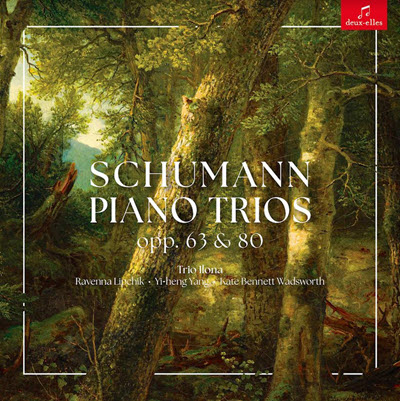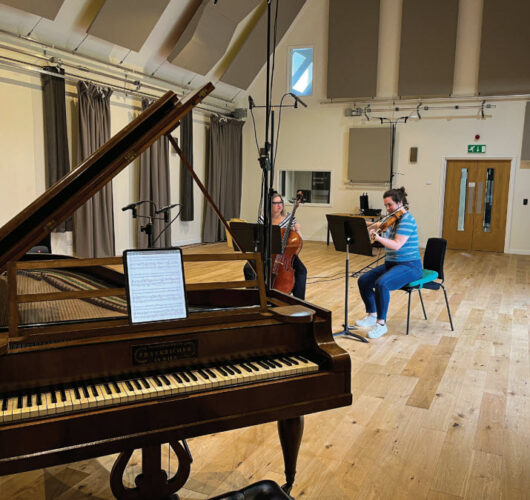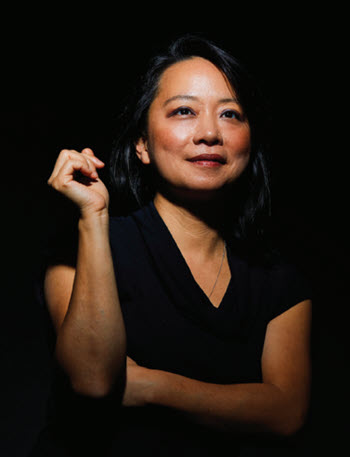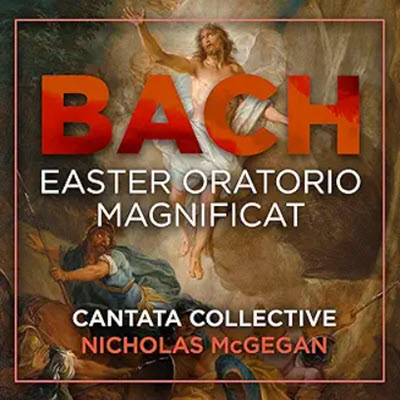by Anne E. Johnson
Published July 21, 2024
Robert Schumann Piano Trios, Opp. 63 and 80. Trio Ilona. Deux-Elles DXL 1197
The “early” in “early music” keeps getting later, and the results can be eye- and ear-opening. In its debut recording on the British Deux-Elles label, Trio Ilona gives the historically informed, period-instrument treatment to two piano trios (Opp. 63 and 80) that Robert Schumann wrote in 1847.

Trio Ilona — pianist Yi-heng Yang, violinist Ravenna Lipchik, and cellist Kate Bennett Wadsworth — is named after one of Clara Schumann’s piano students. This is no empty homage: Because Ilona Eibenschütz lived until 1967, her playing provides a rare example of Schumann-era style captured on modern equipment. The trio studied Eibenschütz’s recordings. As Wadsworth describes it in an interview in the CD booklet, her playing is “very vibrant and speech-like, and sometimes almost jazzy.”
Perhaps the biggest adjustment for the listener accustomed to modern-instrument performances of Robert Schumann is the sound of gut strings. There is no longer a sense that the violin is the primary instrument. Its sound is quieter yet also edgy, offering more friendship than dominance over the intense, fast-decaying tones of the early piano. For this recording, Yang plays an 1830 J.B. Streicher pianoforte. (From Early Music America, Yang’s solo Schumann has already earned much praise.)
As counterbalance, the gut strings of Wadsworth’s cello bring out the treble frequencies of her instrument, equalizing its presence among the three voices.
In the D minor Trio, Op. 63, about halfway through the opening movement (Mit Energie und Leidenschaft – With energy and passion), the piano has a series of triplets, first in the high register and then low, with the strings floating quietly in the background. That moment encapsulates the power of Trio Ilona’s period style. The Streicher piano sounds like a fantastical organism, a dancing skeleton, as Yang loosens the rhythm and allows the weight of each key-strike to vary. Although the violin and cello are playing long notes, their tone sparkles with so many different colors that those sustained lines seem endlessly active.

The second movement of Op. 63, marked Lebhaft, doch nicht zu rasch (Lively but not too fast) has a joyous grittiness. The opening melody traded by Lipchik and Wadsworth in the slow third movement is plaintive without resorting to sweetness. The final movement, Mit Feuer (With fire), sizzles: It’s not just the energy of the playing, but the jagged approach to fast rhythms, unpredictable as flame.

Vibrato is used judiciously throughout the recording, its absence as functional as its presence. The purposefully inexact rendering of repeating rhythms works because there is little or no wobbling of the pitches to hide such details. Yet Lipchik in particular is often effective in breathing life into a note with a quick swell of vibrato that evaporates as quickly as it appeared. The trio’s articulation is often courageous: The violin tremolo in opening of the F Major Trio, Op. 80, chitters like a field of locusts. In the third movement, In mässiger Bewegung (With moderate motion), the asymmetry and natural imperfection of the voices’ interplay makes the music seem to stagger and gasp, like someone trying to take in a new world.
One of the most appealing aspects of this recording is its sonic hyper-realism. We hear the squeak of fingers along strings, the crunch of bow hairs, the slight tick of rebounding piano keys between repeated pitches. Much credit for the unabashedly intimate sound must go to engineer Matthew Wadsworth (a lutenist himself) and producer Andrew Storey, who knew better than to clean up or smooth out the takes. This is not Schumann as an Olympian ideal, but Schumann on a human scale.
Anne E. Johnson is a freelance writer based in New York. Her arts journalism has appeared in the New York Times, Classical Voice North America, Chicago On the Aisle, and PS Audio’s Copper Magazine. She teaches music theory and ear training at the Irish Arts Center in Manhattan. For EMA, she recently reviewed Philadelphia’s Filament ensemble playing Buxtehude.




